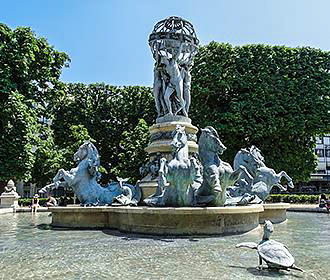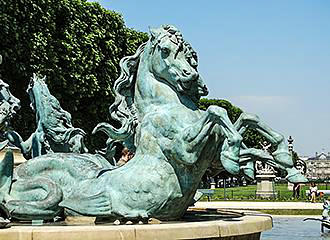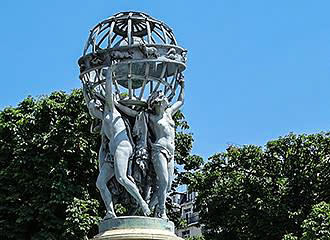Fontaine des Quatre Parties du Monde monumental water fountain in Paris
This is one of the well known monumental fountains in Paris, which is often referred to at the Carpeaux Fountain or the Fontaine de l’Observatoire, and designed in the 1860s to represent the four parts of the world with a celestial globe, this is located within the Jardin des Grands Explorateurs in the Jardin Marco Polo that is classed as an extension of the Luxembourg Gardens.
About the Fontaine des Quatre Parties du Monde
The Fontaine de l’Observatoire, or Fontaine des Quatre Parties du Monde as it is also called, was commissioned by Baron Haussmann during the redesign of the city in the 1800s, which was when the Avenue de l’Observatoire was being constructed on the meridian line and perspective from the Palais du Luxembourg through to the Observatoire de Paris.
And way back in 1867, in conjunction with Gabriel Davioud who was in charge of fountains, gardens and parks in Paris, the artist chosen for the main part of the ornamental design was Jean Baptiste Carpeaux, which is why the fountain is often also referred to as the Carpeaux Fountain.
The sculptor decided to use four female figures as allegories, dancing around supporting a celestial sphere to represent the four parts of the world, and these were to represent Europe, Asia with a long hair braid, America with feathers, and Africa that has a broken chain around the ankle as a symbol of the abolition of slavery.
Jean Baptiste Carpeaux had once been a pupil of Francois Rude, who produced a famous sculpture group on the Arc de Triomphe, yet Carpeaux was more contemporary than the traditional neoclassical style for statues seen previously, and even his sculptures on the facade of the Palais Garnier initially caused a stir, but he received lots of commissions for public works.
But the Fontaine des Quatre Parties du Monde, or Fontaine de l’Observatoire, was produced by more than one artist, and it was Eugene Legrain, who was a pupil of Carpeaux produced the sphere itself with the zodiac signs going around the globe.
Yet it was the sculptor Emmanuel Fremiet, who was the nephew and a pupil of Francois Rude, that produced the bronze horses, dolphins and turtles located within the basin of the fountain at the bottom of the statue, whereas the garlands located around the pedestal were produced by Louis Villeminot.
Although work started on this monumental fountain in Paris back in 1867, it was halted due to the 1870 Franco-Prussian War, and it was not until 1872 that plaster cast models were first presented, one of which can still be seen today within the Musee d’Orsay.
So, the Fontaine des Quatre Parties du Monde was not finally completed in bronze and installed within the southern garden of the Jardin des Grands Explorateurs until 1874, which was the year before Carpeaux died, but is still there in all its glory for all to enjoy today.
Visiting the Fontaine des Quatre Parties du Monde Fountain
As you no doubt read earlier, the Fontaine de l’Observatoire is located at the southern end of the Jardin Marco Polo, within the Jardin des Grands Explorateurs, along the Avenue de l’Observatoire, which is located in the 6th Arrondissement.
Now the garden itself is accessible to the disabled in most areas and you can see the fountain in all its glory, even if you are in a wheelchair. However, we would like to point out that the garden normally opens at around 8am on weekdays and 9am at weekends. But the closing times vary depending upon the time of year, which can be from as early as 5:30pm in winter or as late as 9pm in the summer.
When it comes to getting to the garden and the Fontaine des Quatre Parties du Monde, or Carpeaux Fountain, via public transport in Paris, you will find that the nearest RER train station is the Port Royal stop serving line B.
Yet the nearest Metro station is the Raspail stop serving lines 4 and 6 or alternatively, the bus lines 38, 82, 83 and 91, along with the Noctilien Night Bus Service via lines N01, N02, N14, N21 and N122 will also get you close by, plus there are also three different Velib stations for the bike hire scheme within walking distance as well.


